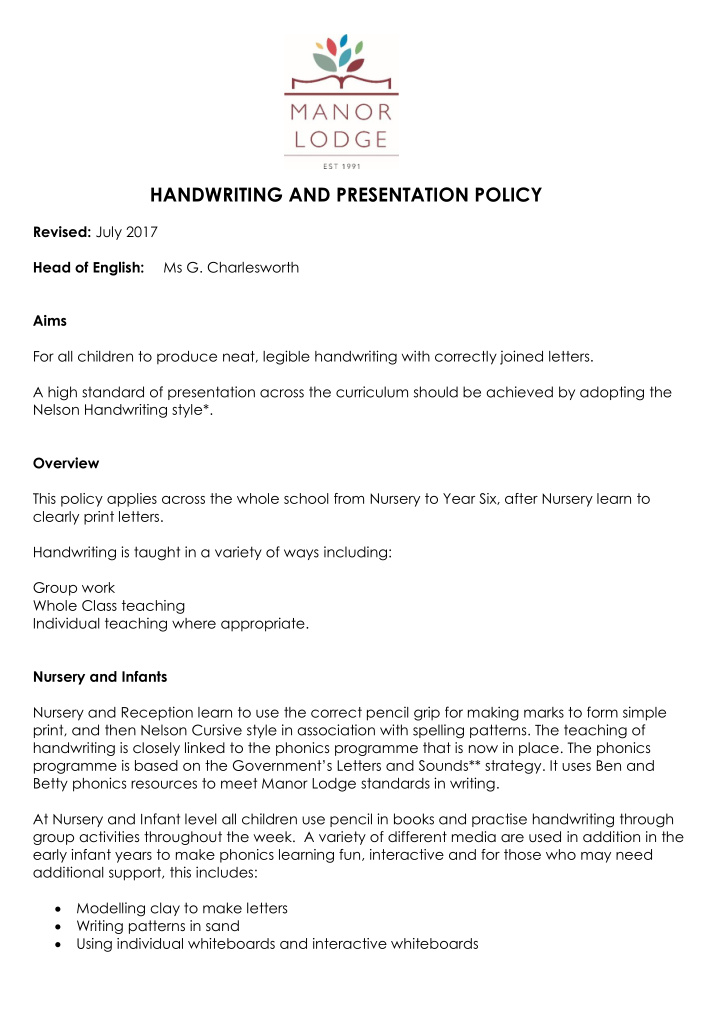



HANDWRITING AND PRESENTATION POLICY Revised: July 2017 Head of English: Ms G. Charlesworth Aims For all children to produce neat, legible handwriting with correctly joined letters. A high standard of presentation across the curriculum should be achieved by adopting the Nelson Handwriting style*. Overview This policy applies across the whole school from Nursery to Year Six, after Nursery learn to clearly print letters. Handwriting is taught in a variety of ways including: Group work Whole Class teaching Individual teaching where appropriate. Nursery and Infants Nursery and Reception learn to use the correct pencil grip for making marks to form simple print, and then Nelson Cursive style in association with spelling patterns. The teaching of handwriting is closely linked to the phonics programme that is now in place. The phonics programme is based on the Government’s Letters and Sounds ** strategy. It uses Ben and Betty phonics resources to meet Manor Lodge standards in writing. At Nursery and Infant level all children use pencil in books and practise handwriting through group activities throughout the week. A variety of different media are used in addition in the early infant years to make phonics learning fun, interactive and for those who may need additional support, this includes: Modelling clay to make letters Writing patterns in sand Using individual whiteboards and interactive whiteboards
Painting Use of interactive white board programmes Children have handwriting lessons every week. The aim is for children to use a joined style of handwriting, this begins with early joins in Reception and Years One to becoming more fluent by Year Two. Children are encouraged to use the correct grip when using any writing, colouring or painting tool. Writing pencils will be selected according to a child’s particular needs. Children are not expected to move onto using a pen in the Infants. Juniors At Junior level children use HB pencils until they progress to using pen through producing consistently neat, joined and well-formed handwriting. A pen licence is issued when a child is able to write neatly and consistently. If a pen licence has not been achieved by the end of Year 3, a licence will not be issued. Such children should use a pen in their writing practice books to encourage neat writing with a pen. From Year 4 all children should use pen whether a licence has been issued or not. Children can use blue: Berol pens, fountain pens or other iradicable blue ink pens. Permanent ink Biros and gel pens are not permitted. Children continue to underline in pencil. Handwriting is taught once a week in Years One to Five and as appropriate in Year Six (dependent on entry exam timetables and individual child requirements). Extra support, for children with poor handwriting, will be given by the Class Teacher. General Display writing throughout the school in the Nelson Handwriting style. Each class has access to the Nelson Handwriting Font on the computer so that teachers can choose to use it when using interactive whiteboards, to reinforce this style. Teachers should model a clear, cursive handwriting style when writing on the Smart board or Whiteboard, and when making comments in a child’s exercise book. Teachers are aware that they are modelling the skill of handwriting at all times. Handwriting and Presentation Motivational Awards Children are encouraged to use neat and appropriate handwriting styles through a system of handwriting awards, each carrying house points: Weekly class certificates (Infants) Monthly year group awards (Infants) Termly year group awards (Infants and Juniors) 2
Annual Infant and Junior prizes including a Year 6 and 2 award at the end of the summer term Written Presentation All written work should be dated using the full date from Year 1 upwards. From Year 2, miss one line before writing the title. The date and title must be underlined, in pencil, using a ruler, from Year 1 upwards. Miss ONE line before starting work. Grammar Exercises 1. When copying from a text, all pupil errors will be corrected. 2. Each answer should start on a new line. 3. Leave a line between answers as appropriate. Comprehension 1. All answers should be complete sentences unless stated otherwise 2. Miss a line b etween answers to allow room for teacher’s comments/corrections. 3. From Year 3, a standardised mark scheme is followed for each comprehension and a total is given for the work. Creative Writing On the introduction of paragraphs in Year 2, a line is left between paragraphs. From Year 3, the first line of each paragraph should be indented. Paragraphs follow on, with no lines between them. Other Curriculum Areas All other subjects should be presented in line with English presentation and marked appropriately to the task and individual child. Comments should be made where possible. These guidelines present the minimum for marking procedure and individual teachers will wish to add to them. Maths Presentation and Marking Work should be ruled off from the previous day, so as not to waste space and a new date is written. All work should be dated using the short date i.e. 5.9.11 and given a title. Both the date and title must be underlined in pencil using a ruler. Miss ONE line before starting work. 3
All corrections should be re- written and completed where possible or a tick and a ‘ c’ can be written to show the work has been corrected. In the Early Years and Infants, the teacher will indicate if the child has had assistance with the work. Any short tests can be marked by the children otherwise all work must be marked by the teacher. * Nelson Handwriting, by Anita Warwick (Nelson Thornes 2003) ‘Nelson Handwriting is the definitive course for developing a fluent and legible handwriting style…… (with) careful progression from pre-writing patterns to the development of an individual style .’ Nelson Thornes Ltd **Letter and Sounds – The Principles and Practice of High Quality Phonics 2007 National Strategies https://www.gov.uk/government/uploads/system/uploads/attachment_data/file/190599/Letters_and_Sounds_- _DFES-00281-2007.pdf Please also refer to the Marking Policy 4
Recommend
More recommend